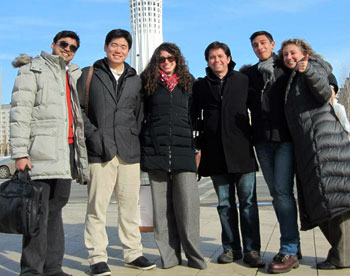ASTANA – As part of the State Programme of Accelerated Industrial and Innovative Development of Kazakhstan for 2010-2014, JSC “National Agency for Technological Development” (NATD) has been working in partnership with Columbia University since 2011 to identify new promising areas of technological and innovation development and the formation of recommendations based on best international practices.

Students from Columbia University believe their research projects in Kazakhstan are mutually beneficial.
In 2011, the subject of the project was to analyse the innovative development of Kazakhstan. In 2012, the report highlighted the development and gave further recommendations to strengthening the venture capital financing of innovative projects. This year, the project focuses on energy efficiency of industrial enterprises in Kazakhstan.
The Ministry of Industry and New Technologies, the Ministry of Environmental Protection, JSC “KazahEnergo Examination,” JSC “Kazakhstan Institute of Development of Industry,” and others found the idea of the project very interesting. The project also fits perfectly the theme of the upcoming EXPO 2017 which is to focus on alternative sources of energy.
President Nursultan Nazarbayev, in a recent speech about the country’s transition to a “green” economy, has focused on the development of recommendations in “green energy” and the effective support of small and medium enterprises, using environmentally friendly technologies. This makes the joint research project in this area very important.
The Kazakhstan government has expressed its desire to initiate appropriate measures to avoid the “oil curse” and its concomitant negative pressure on the non-energy sectors of the national economy, especially on manufacturing and small and medium-sized enterprises (SMEs).
Thus, the government has introduced several important steps towards the sustainable management of energy revenues. These steps included the introduction of the State Programme of Accelerated Industrial and Innovative Development (PAIID) and the Green Bridge Strategy in 2011. The purpose of establishing these national strategies is to stimulate the non-oil sectors of the economy, especially the “green economy” sector, to promote the competitiveness of the national economy in the international market, and to identify and support SMEs to work on the introduction of innovative new technologies including “green technologies”.
This year’s team will continue the assessment of the measures undertaken by the Kazakhstan government in improving the national and legal environment under the PAIID and Green Bridge Strategy. The students focus on evaluating what options exist for existing entrepreneurs in the current SME space, and how these can be expanded; what green economy policies are being implemented by the government and how these can be integrated in the SME sector; what other comparable countries’ policies exist in the SME-green economy interface, and whether comparable strategies can be applied to Kazakhstan.
As part of the research, students review government and other relevant sources and other specialized literature, interview international experts, including consultants and trade experts in the USA with relevant country and sector knowledge. They also conduct interviews with relevant experts in Kazakhstan including programme managers, policymakers, representatives of international organizations such as the World Bank, and private sector actors, especially small and medium-sized enterprises, to gather comparative information.
“We greatly enjoyed working with NATD. The objective of the project was to prepare a set of recommendations to promote energy efficiency in Kazakhstan’s industrial sector. We were interested in this project because energy efficiency and, as a whole, green economy, is a national priority for Kazakhstan to ensure competitiveness and sustain high levels of economic growth going forward. Through a combination of international case study analysis, interviews with experts and field study, we were able to develop policy recommendations to improve institutional, technical and financial capacity for energy efficiency in the industrial sector,” Marina Leytes, representative of the American students team, said.
“In particular, our recommendations included legislative aspects, such as amendments to the current law on energy efficiency, to facilitate its implementation and increase its likelihood of success, as well as financial incentives to support investments in energy efficiency. We expect our work to contribute to the dialogue on energy efficiency in the industrial sector of Kazakhstan, and we hope that some of the recommendations will be implemented in the short to medium term, subject to specific constraints faced by the policy makers,” she continued.
“As part of the project, the team had an opportunity to visit Astana and Almaty. We conducted a series of interviews with government agencies, international organizations as well as financial sector players in order to understand the current situation. We are grateful to NATD and other stakeholders with whom we have met for their support of the project,” Leytes explained.
“We have also been humbled by the hospitality and warmth of the people of Kazakhstan, which made our trip enjoyable and memorable despite the cold weather! We have heard about Kazakhstan before as the largest economy in Central Asia and one of fastest growing economies in the world. As we study economic development issues, Kazakhstan presented an interesting case for us as its economic growth is largely natural resource driven and, therefore, is vulnerable to commodity price fluctuations. Therefore, we felt that the project on energy efficiency was of real importance, which encouraged us in our work,” she continued.
Recently, the group presented its findings to some of the stakeholders via a teleconference organized by the NATD.
“We have received many comments and questions, which showed great interest in the topic and our work,” Leytes said. “We hope our recommendations will be helpful and that NATD will continue its cooperation with Columbia University in the future.”
NATD continues to see its role in giving full support to the work of group of students in Kazakhstan. The students arrive in Kazakhstan and for 14-15 days are meeting with potential beneficiaries and other organizations, which are interested in the results of the project, doing interviews and sharing information.
“As we are working with Columbia University for the third year in a row, we decided to strengthen our relationship by signing a memorandum this year,” Aiman Kyrbassova, expert of NATD’s Centre of Analytical and Methodological Support, said.


